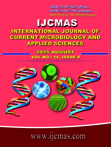


 National Academy of Agricultural Sciences (NAAS)
National Academy of Agricultural Sciences (NAAS)

|
PRINT ISSN : 2319-7692
Online ISSN : 2319-7706 Issues : 12 per year Publisher : Excellent Publishers Email : editorijcmas@gmail.com / submit@ijcmas.com Editor-in-chief: Dr.M.Prakash Index Copernicus ICV 2018: 95.39 NAAS RATING 2020: 5.38 |
Environmental bioengineering is continuously escalating its efforts in the biotic treatment of textile effluents, which is an ecologically friendly and affordable alternative to physico-chemical putrefaction processes. In the present study, effluent samples were collected from various textile and dyeing industries located in and around Tiruvannamalai, Tamilnadu, India and were exploited for the screening and isolation of bacterial strains that were capable of decolorizing the textile dye, Acid Red-88. Optimization of cultural conditions (Temperature, pH, Agitation speeds and Dye concentrations) were carried out to maximize the decolorization efficiency of AR-1 towards Acid Red-88. Decolorization efficiency was found to be optimized at 35°C, neutral pH, after 24 h of incubation. Static conditions proved to be effective in maximizing decolorization. Increase in dye concentration decreased decolorization efficiency of AR-1. Detoxification of Acid Red-88 textile dye by AR-1 was confirmed by Phytotoxicity studies on Macrotyloma uniflorum.
Arulprakash, A., K. Sathishkumar, M. S. AlSalhi, S. Devanesan, P. Mani, S. Kamala Kanan, S. Vijayanand, A. Rajasekar (2022). Integrated approach of photo-assisted electrochemical oxidation and sequential biodegradation of textile effluent. Environmental Pollution. 307 (15), 119412. https://doi.org/10.1016/j.envpol.2022.119412.
Aswinkumar, S., N. Arunagirinathan, S. Vijayanand, J. Hemapriya and Indra, V. (2017). Bioremediation and Detoxification of a Textile Azo Dye-Evans Blue by Bacterial Strain AKIP2. Int. J. Curr. Microbiol. App. Sci. 6(5): 2687 - 2694. http://dx.doi.org/10.20546/ijcmas.2017.604.313.
Barathi, A., J. Hemapriya, Ramya Gunasekaran, Kayeen Vadakkan, A. Shyamala, Aswini Ravi and Vijayanand, S. (2020a). Bioremediation of Textile and Tannery Effluents – An Overview. Int. J. Curr. Microbiol. App. Sci. 9(11): 3782- 3790. https://doi.org/10.20546/ijcmas.2020.911.454.
Barathi, A., J. Hemapriya, Ramya Gunasekaran, Kayeenvadakkan, A. Shyamala, Aswini Ravi and Vijayanand, S. (2020b). Biodegradation and Detoxification of Congo Red by Intuitive Bacterial Strain TVU-CR4. Int. J. Curr. Microbiol. App. Sci. 9(11): 3772-3781. https://doi.org/10.20546/ijcmas.2020.911.453.
Bavani, T., J. Madhavan, S. Prasad, M. S. AlSalhi, M. A L Jaffreh and S. Vijayanand. (2021). Fabrication of novel AgVO3/BiOI nanocomposite photocatalyst with photoelectrochemical activity towards the degradation of Rhodamine B under visible light irradiation. Environmental Research 200 (2021) 111365. https://doi.org/10.1016/j.envres.2021.111365.
Das, H.S., Reshma Girirajan, Rajalakshmi Balaji, S. Vijayanand and Hemapriya, J. 2024. Sustainable Approach for the Bioremediation of Textile Azo Dye – Metanil Orange by Textile Effluent Adapted Bacterial Strain JHP-1. Int.J.Curr.Microbiol.App.Sci. 13(6): 278-285. https://doi.org/10.20546/ijcmas.2024.1306.030.
Hemapriya, J and S. Vijayanand. (2013). Bioremediation of Structurally different textile dyes by a novel bacterial consortium. Int.J.Curr.Microbiol.Appl.Sci., 2(11):212- 226.
Hemapriya, J. and S. Vijayanand. (2014). EcoFriendly Bioremediation of a Triphenylmethane Dye by Textile Effluent Adapted Bacterial Strain VP-64. Int. J. Current.Microbiol. Appl. Sci., 3(9): 983- 992.
Hemapriya, J., Rajesh Kannan and S. Vijayanand. (2010). Bacterial decolorization of textile azo dye Direct Red-28 under aerobic conditions. J. Pure Appl. Microbiol., 4(1):309-314.
Hemapriya, J., Rajesh Kannan and S.Vijayanand. (2010). Bacterial decolorization of textile azo dye Direct Red-28 under aerobic conditions. J.Pure Appl.Microbiol., 4(1):309-314.
Huang, Y., Zhang, X., Zhua, G., Gao, Y., Cheng, Q., Cheng, X., 2019. Synthesis of silver phosphate/sillenite bismuth ferrite/graphene oxide nanocomposite and its enhanced visible light photocatalytic mechanism. Separ. Purif. Technol. 215, 490–499.
Kalyani, D. C., A. A. Telke, R. S. Dhanve and J. P. Jadhav. (2009). Eco-friendly biodegradation and detoxification of Reactive Red-2 textile dye by newly isolated Pseudomonas sp. SUK1. J. Haz. Mat., 163:735-742. https://doi.org/10.1016/j.jhazmat.2008.07.020.
Liu, X., Guo, Z., Zhou, L., Yang, J., Cao, H., Xiong, M., Xie, Y., Jia, G., 2019. Hierarchical biomimetic BiVO4 for the treatment of pharmaceutical wastewater in visible-light photocatalytic ozonation. Chemosphere 222, 38–45.
Malathi, A., Seung, J.L., Talshyn, B., Shreyanka, S.N., Yiseul, Y., Hyeyeon, L., Theerthagiri, J., Choi, M.Y., 2021. Enhanced photocatalytic activity at multidimensional interface of 1D-Bi2S3@2D-GO/3D-BiOI ternary nanocomposites for tetracycline degradation under visible-light. J. Hazard Mater. 404, 123868.
Puvaneswari, N., J. Muthukrishnan and P. Gunasekaran. (2006). Toxicity assessment and microbial degradation of azo dyes. Ind. J. Exp. Biol., 44:618-626.
Saratale, G.D., S.D.Kalme and S.P.Govindwar. (2006). Decolorization of textile dyes by Aspergillus ochraceus (NCIM-1146). Ind. J. Biotechnol., 5:407- 410.
Saratale, R. G., G. D.Saratale, D. C. Kalyani, J. S. Changand S. P. Govindwar. (2009). Enhanced decolorization and biodegradation of textile azo dye Scarlet R by using developed microbial consortium GR. Bioresour. Technol., 100: 2493-2500.https://doi.org/10.1016/j.biortech.2008.12.013.
Sharma, K., Dutta, V., Sharma, S., Raizada, P., Hosseini-Bandegharaei, A., Thakur, P., Singh, P., 2019. Recent advances in enhanced photocatalytic activity of bismuth oxyhalides for efficient photocatalysis of organic pollutants in water: a review. J. Ind. Eng. Chem. 78, 1–20.
Shyamala, A., J. Hemapriya, Kayeen Vadakkan and S.Vijayanand. (2014). Bioremediation of Methyl Orange, a Synthetic azo dye by a Halotolerant Bacterial strain. Int. J. Current Research and Academic Review. 2(8):373- 381.
Vijayanand, S. and J. Hemapriya. (2013). Bacterial bioremediation of textile azo dyes A Review. Ind. J. Appl. Res., 3(12): 480-482.
Vijayanand, S., Kayeen Vadakkan and Hemapriya, J. (2017). Ecofriendly Bioremediation of Acid Orange - An Electron Deficient Xenobiotic Chromogen by Haloalkaliphilic Bacterial Consortium TVU- AO 64. Int.J.Curr.Microbiol.App.Sci., 6(4): 956- 963. http://dx.doi.org/10.20546/ijcmas.2017.601.113. |
 |
 |
 |
 |